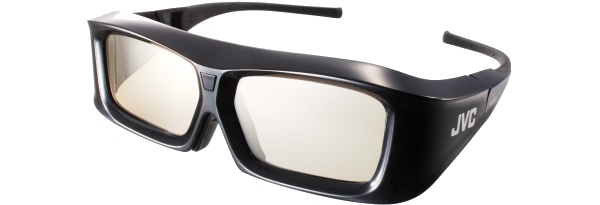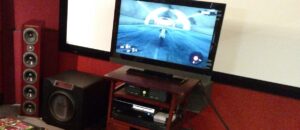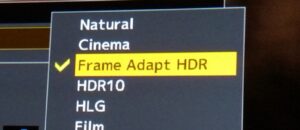As I posted a couple weeks ago, I’ve recently installed a new JVC DLA-RS40 projector in my home theater. When I gave my first impressions of the display, I hadn’t yet done much testing of its 3D capabilities. In the meantime, I’ve had a chance to play around with the 3D a little more. Today, I’ll offer my (at least initial) impressions of that aspect.
Keep in mind that, although I’ve seen a bunch of 3D movies theatrically, this is the first that I’ve spent any extent of time with home theater 3D (beyond the occasional brief demo). We have a few Blu-ray reviewers on staff who’ve put a lot more time in with 3D HDTVs. I’m not certain yet that I have everything optimized to get the best from the format, and am not comfortable enough that I’d be ready to actually review 3D discs. With that said, 3D was one of the biggest reasons that I wanted to upgrade in the first place, so I’m eager to put the feature to use.
The DLA-RS40 is a frame-sequential 3D display. It requires active shutter glasses, not the (less expensive) passive type. The benefit to this is that the projector provides full 1080p resolution per each eye in 3D mode, unlike passive displays which cut the vertical resolution in half for 3D. Also, the projector claims to be 3D ready with even a basic white screen. No special silver screen is needed. That’s important, because the silver screens tend to wreck regular 2D viewing.
In order to use 3D on the RS40, you must purchase the 3D glasses and a 3D sync emitter each separately. I ordered a pair of JVC’s own glasses, plus a pair of XpanD X103 universal glasses for comparison. The sync emitter was very easy to install. You basically just plug it in and it starts working as soon as the projector receives a confirmed 3D signal. The sync emitter also triggers the JVC glasses to turn on automatically. (They even turn off by themselves a few minutes after the signal stops.) The XpanD glasses must be manually turned on and off with a button on the side. I fear that I’ll forget to turn them off and inadvertently drain the battery.
XpanD actually manufactures JVC’s 3D glasses as well. Other than the company logo and the XpanD power button, both pairs look and feel physically identical. However, their lenses have different properties that I’ll get to shortly. Both pairs are a little bulky and not particularly comfortable, but will fit over my regular prescription glasses.
My Blu-ray 3D player is an OPPO BDP-93, connected (of course) by HDMI. I only have a few Blu-ray 3D discs so far. I’ve done most of my testing with ‘Resident Evil: Afterlife‘, which our reviewer Nate says is among the best 3D demo discs. I’ve watched the opening sequence to that film dozens of times by now.
When it comes to front projection, one of the biggest issues with 3D is brightness. Although the RS40 will work with a plain white screen, different types of screen material interact differently with the 3D glasses. Screens that retain polarization of the light from the projector are said to appear brighter through the 3D glasses than screens that don’t. My matte white screen apparently does not retain any polarization. When the glasses lock into 3D mode, I would roughly guesstimate that I lose about 75% brightness. At least, that’s what it looks like. At my default calibration settings that look great with regular 2D content, 3D is unwatchably dim.
I compared the JVC and XpanD glasses. As far as brightness is concerned, I see no difference on my screen. I’ve read that the JVC glasses are better if the screen material retains some polarization. If the screen doesn’t (like mine), they’re about equal. Both pairs of glasses have a red push, but to different degrees. I found the JVC glasses preferable to my eyes and easier to compensate for. But, again, your results may vary with different screen material.
The projector has a “3D” preset mode to compensate for the brightness and color issues. Among other things, it kicks the lamp into High power, boosts the color temperature to the 8500k setting (6500k is “correct” for normal viewing), and applies a custom gamma curve to increase the brightness of mid-tones. The picture is indeed much brighter and more watchable this way. However, like most factory preset modes on any TV or HD display, I seriously doubt that it’s very accurate from a calibration standpoint. For one thing, the preset has no way of knowing what your screen properties are or even which 3D glasses you’re wearing. To the eye (through the glasses), the mode certainly looks like it’s been artificially manipulated. I don’t trust it any more than I can trust the “Vivid” or “Anime” or “Stage” presets. These things are meant for newbie users who don’t know any better.
Also, the High lamp mode kicks the cooling fan into high gear and is much louder than the default setting. The projector is basically whisper quiet in normal operation, but in my room with the projector pretty close to my head, the High lamp setting is too loud to watch a movie.
Starting with the 3D preset, I bumped the lamp power back down to the normal setting and then tried to make other adjustments that would improve brightness in a comparable fashion.
Unfortunately, there are no 3D calibration discs available yet, but I can manually force the projector into a “top/bottom” 3D operation when watching a standard 2D calibration disc. The picture is badly distorted this way, but certain basic test patterns are still usable. I managed to adjust the “Brightness” (black level) and “Contrast” (white level). More complex settings such as color temperature and gamma have to be tweaked by eye. Even if I had a colorimeter and other professional calibration tools here, what they’d measure off the screen wouldn’t be the same as what I see through the glasses. For now, there’s just no satisfying way to calibrate a 3D picture with any accuracy. The best I can do is eyeball it until I think it looks OK. That’s frustrating at best.
What I settled on was to leave the gamma at the “3D” preset, basically because I don’t know what else to do with it yet. I then raised the color temperature to the 9000k setting, which seems to best compensate for the JVC glasses’ red push. The picture isn’t quite as bright as 2D viewing, but it’s a lot more watchable than it was before.
The first thing I discovered after my first night of 3D viewing was that I may be one of those people who gets a headache from active shutter 3D. A serious headache. I’ve never had a problem with the passive forms of 3D in IMAX or RealD theaters, but a few hours of 3D usage with this projector left me with a three-day headache that was totally resistant to Tylenol.
Now, there may be other factors that contributed to that headache. Mainly, my attempts to set-up and calibrate the 3D meant that I was straining my eyes a lot more than I would during normal movie watching. I wasn’t ready to give up, but I did need a few days off from 3D watching after that first night. I still get some eye strain after subsequent viewing attempts, but haven’t had another headache quite that serious. I’m sure that the 3D is just something that I’ll get more used to over time.
Anyway, how does the 3D look? Well, it works. That much I can say for certain. There’s definitely a noticeable 3D depth effect. Everything that I’ve watched so far has extended from the screen surface backwards. I’ve seen absolutely none of the classic 3D popping-out-of-the-screen effects. When I’ve watched 3D movies theatrically, even films that try to focus more on depth than on gimmicky “Comin’ at ya!” gags still have at least some imagery that extends forward from the screen. I’ve seen nothing like that here.
The opening to ‘Resident Evil: Afterlife’ has a whole lot of gimmicky shots where things like ninja stars and bullets fly directly towards the camera in a way that really seems like they should be right in your face. Nevertheless, the screen is basically a glass wall that nothing breaks through.
It’s not even that I want to see stuff flying in my face. I’m just concerned that I may have something set up wrong, because I do expect to get some of that.
Another problem is that, at least in some scenes, the 3D effect I’m seeing is of the “cardboard cut-out” variety, where the picture looks like several flat 2D images that have been layered in front of another other, rather than a rounded and dimensional true 3D image.
While Nate’s review of ‘Afterlife’ says that the disc has a whole lot of popping-out effects, I’ve read elsewhere that this disc is actually quite divisive among viewers. Some find it among the best 3D available, and others say that it’s entirely underwhelming. Perhaps there’s something with the way this movie was shot (or the way the disc is encoded) that reacts differently to different display types? Or maybe I just have something set up wrong? I’m really not sure at this point.
With that said, the ‘Afterlife’ disc is pretty impressive at other moments. There’s a scene where two clones of Milla Jovovich jump out a window and plummet down a deep shaft that’s a really stunning use of 3D.
As far as crosstalk artifacts go, I haven’t seen much of an issue with that so far. ‘Afterlife’ is supposed to be pretty minimal in that respect anyway, so perhaps it’s not the best test case. In reading up about the JVC RS40 in online home theater forums, it’s been said that the projector needs a warm-up period of at least 20 minutes or so to watch 3D. Before that, crosstalk artifacts may be pronounced. Honestly, every time I’ve turned on 3D has been after at least a couple hours of 2D viewing, so I can’t validate these claims.
Other reports have it that the projector sees negligible crosstalk problems with a 24 fps Blu-ray 3D source, but suffers worse crosstalk on 60 Hz 3D video signals such as broadcast TV or video games. I’ve bought one 3D PS3 game (‘MotorStorm: Apocalypse’) and didn’t see any crosstalk there either. The game is a racer that looks really stunning in 3D, but still has no popping-out effects on my screen.
If I sound somewhat underwhelmed with 3D on the JVC RS40, try to keep that in perspective. My testing has still been pretty limited. I need more time with this, and a greater variety of content before I can make any definitive conclusions. At least some of the 3D I’ve watched so far (especially the ‘MotorStorm’ game) has been truly incredible. In fact, I switched back to 2D to replay a level of that game for comparison, and it wasn’t even 1/10 as much fun to play. I may even go so far as to say that there’s no point in playing a racing game without 3D anymore. The 3D experience is just that mind-blowing. (This comes from someone who isn’t much of a gamer, though.)
In addition to the JVC projector, this past weekend I also added a new Vizio passive 3D TV to my home theater room. I’ll get to my experiences and comparisons with that in a future post.






William Henley
Try this – http://www.amazon.com/exec/obidos/ASIN/B003Z2LAAO I have had several people admit its some of the best 3D they have seen.
Jared Chamberlain
hey Josh, you should check out Killzone 3 on the PS3, its a killer game, its fully 3D capable, and there’s a 3D demo available on the PSN store, assuming it will be up in a few days. Also, if you’re a fan of the thriller genre, you should check out Heavy Rain, also on PS3, the story itself has great depth, and I believe that there is a 3D patch for the retail disc as well as a full 3D demo available when the PSN store is back online.
Speaking of the upgrade to 3D, I was looking into the Mitsubishi 3D DLPs and was curious if you’d heard anything about the 738 or 838 series. I know they put out a firmware update that eliminates the need for an external converter, but all the reviews I’ve read so far, were pre firmware update…
Josh Zyber
AuthorI’m going to have a poll about 3D games running first thing tomorrow.
I’ve done some reading about Killzone 3, and that game supposedly has some of the worst 3D crosstalk anyone has ever seen.
Eric Hulen
The crosstalk is only bad during the cut scenes. The gameplay is crosstalk free it’s just downrezzed.
Eric Hulen
Also try the demos of Super Stardust HD and Wipeout HD. Those are the two best examples of 3D games besides MotorStorm on the PS3.
Javier
“the screen is basically a glass wall that nothing breaks through.”
That pretty much sums up my experience with 3D as well. I remember going to Disney Land as a child and watching Captian Eo. Things were hovering inches from my face it seemed. We would actually reach out to touch them! That hasn’t happened with these new 3D movies to me so far. They just seems to have a lot more depth. I’ve watched 3D movies at my local theater and at my parents house but so far I haven’t seen anything that comes close to Captain Eo. My parents bought a 60′ Samsung plasma so I’ve been messing with that, but they only have the Shrek movies in 3D and I have Tron so my selection has been limited. From what I’ve seen though, its just the same as my Nintendo 3DS. Nice depth but I’m certainly not reaching out to touch. I’m going over to visit this weekend so I’ll take one of my consoles and try out the games though.
Luke Hickman
Agreed. I realized this fact when I saw my first realD movie, Monster House. The new tech of 3D made it look like you were gazing into a stage, not having things pop out at you. I love 3D when it is used with stage looks, but the eye popping things drive me crazy because they simply do not pop out.
William Henley
If I remember right, Journey To The Center of the Earth had some of those “objects popping off the screen” moments, but that seemed really limited.
The movie I linked to up top, Grand Canyon: River at Risk, seems to have some stuff that extends slightly off the sides of the screen and slightly forward, but most of it does extend back. Its why I like it – it seems to give a good 3D effect without seeming gimmicky or looking like a picture-window.
What I really like is converting 2D to 3D (okay, I don’t have a real 3D experience yet, converting this stuff to Anaglyph using Total Media Theater, but I plan to fix that soon). Josh, that may be something you wish to try out – try hooking your computer up to the projector, and check out Total Media Theater – they have settings where you can adjust how pronounced the 3D effect is. Its also REALLY cool on the opening scene of Aladdin.
Prayformojo
I have a passive Vizio set and have been extremely pleased with the 3D. The pop-out effect is very limited and I have only seen a few sequences that have true pop-out, but I love the extra depth that 3D adds.
Josh Zyber
AuthorCan you cite a specific disc/scene where you’ve seen a pop-out effect? I’m just concerned that I’ve set up something wrong, because I’m not seeing that AT ALL on either the projector or the Vizio passive set I just bought. If I can confirm just one instance where it works, I’ll feel a lot better. 🙂
EM
You’ll pop your eye out, kid!
William Henley
http://www.arcsoft.com/estore/software_title.asp?ProductCode=TMT5P
Halfway down the page, they show a screenshot of their 3D settings, and you can control the depth perception.
Actually, I wouldn’t be surprised if your projector has a setting to control the depth perception.
Anyways, I would download the trial of that software and test it out.
Its also fun to view photos in 3D. Some give you really weird effects, but some are fun. Its also fun to check out some old home videos. Its not like something filmed in 3D, but it does well on depth (especially if there is water, from like pools or lakes), and was really fun to relive some old memories. Yeah, the conversion is a gimmick, but it actually works pretty darn good depending on what the source is.
Tony
One of the best popout effects I’ve seen is in “Imax Under the Sea”. About 20 minutes in a big codfish really pops out at you. It was great – my wife & kids were trying to grab it.
This was viewing on a 52″ Sony XBR9.
that1guypictures
Josh – make sure you try the lantern scene in Tangled. When Flynn Ryder releases the lanterns and begins to sing, the lanterns fly forward and seemingly into your lap. Also make sure you aren’t sitting too close. You should be sitting about 2x-3x the width of the screen or your going to lose some of the depth and spatial cues by sitting too close. I’ve had my 3D Panasonic for over a year now, and have experimented with tons of 3D sets at my job. (Best Buy/Magnolia.) Tangled is our go to demo disc. I’ve seen Resident Evil, Tron and others…but Tangled and How to Train Your Dragon are the only titles that continue to impress me every time I rematch them on a daily basis at work.
javier aleman
to me 3D is bout having something exist outside of the screen, not just necessarily just jump out at you. This enhanced depth isn’t quite enough to convince me just yet. It’s kind of like 120mhz, 240mhz, 480mhz…etc where everything looks like it was filmed with a news camera. i can’t decide if all this new tech will enhance my viewing experienceand if I even want it at all.
William Henley
Really? You know what processor speed your TV is running at? :-p
Barsoom Bob
Wrote some of this in another thread a week or so ago but just to add to the conversation.
The home theater 3D does seem to favor the “looking through the window” type depth and not so much the “in your face experience”, it is there but it is subtler than the big screen presentations. I think this is a factor of size and distance that cannot be achieved in home surroundings. Your brain can’t stitch together the two disparate images and put them into perpective when you are at normal living room distance away from the screen.
Some examples of “comin’ at ya” 3D :
Christmas Carol – Marley practically throws his chain and weights into your living room when he first comes to see Scrooge
Imax Under the Sea – there is one grouper fish about half way through the film that sticks his head pretty far into my living room.
IMO Good Blu 3D :
Tangled – Alice in Wonderland – Avatar – Tron Legacy (parts are in 2D)- William is right, Grand Canyon Adventure – also IMAX : Tahiti Ultimate Wave and Under the Sea
Did not like “Afterlife” as a movie or as a good example of Blu 3D
3D PS3 Games – C.O.D. Black Ops – Crysis 2 –
MLB The Show and NBA 2K11. Didn’t know Enslaved was 3D enabled until reading your list this morning. That could be good, a third person adventure type game. Waiting for Uncharted 3 in the fall, it will be 3D enabled.
I too am using my 3D set for more 3D gaming than 3D movie viewing.
I never view anything in 3D for more than a couple of hours at a time. Glasses free 3D would be sweet but isn’t going to happen until bio inplants become available. (I’m only half joking) The guy who is going to clean up is the guy who can make these glasses much lighter in weight and have them go from clear to blocked. He will make a small fortune.
RJ Macready
I think there’s something awry with your setup. Resident Evil: Afterlife has a number of popout effects throughout when I’m watching on my Mitsubishi 60638 via a PS3. Most BR3D discs I’ve watched have some sort of popout effect, even the lame, post-converted ones like Green Hornet 3D.
Jacob
I got a panasonic tcp50gt25. director james cameron released a special 3d setting for both the vt and gt25 models last year. I have been using that. its work great for avatar and all other 3d titles.
http://panasonic.net/avc/viera/us2010/avatar/index.html
Jacob
AlbertX
Well you shouldnt worry that much I cant see that anything popping out either, I think is an aye problem, as a child in The Muppets 3D I remember seing stuff popping out, the same as in the Nightmare on elm Street 6 movie even with the red blu glasses, but with these movies I just cant see anything popping out
Josh Zyber
AuthorThe thing is that I DO see some popping-out effect in theaters. But I haven’t experienced it a single time yet at home.
Bluejello13
Thank you Josh. I’m very happy that you wrote this article. Your experiences have pretty much mirrored mine. I love the depth of the image with most every 3D movie I’ve seen. Check out the water ski/fireworks scene from Yogi Bear. That is the only scene I really felt had some pop out effects. I upgraded to 3D not for the gimmick of it, bit the added depth. That extra depth in the image is what I’ve seen and I’m very happy with my purchases. I am anxious to get some way to calibrate my set for the 3d mode as I have also noticed a sharp drop in brightness and ability of the set to show true black.
As far as ps3 games go, motorstorm rift actually had a ton of dirt and smoke the flies out of the screen. But the seem to have eliminated that from apocalypse. Killzone and call of duty black ops both gave me headaches like you described (movies don’t though, but I believe that’s because of the amount of eye activity used during a game vs a movie). Crysis 2 though was absolutely phenomenal.
Anyway, thanks again. Good luck and enjoy.